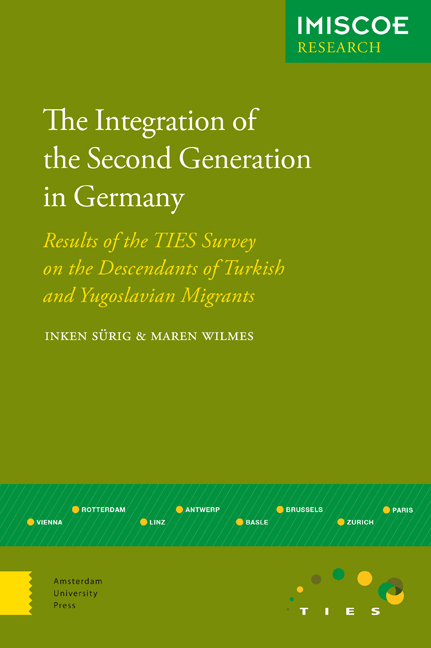 The Integration of the Second Generation in Germany
The Integration of the Second Generation in Germany Book contents
- Frontmatter
- Contents
- Preface: The International Research Project TIES
- 1 Introduction
- 2 Migration History and Basic Demographic Characteristics of the First Generation
- 3 Educational Careers and Educational Outcomes
- 4 Labour Market Positions
- 5 Segregation and Housing
- 6 Ethnic and Cultural Orientations
- 7 Social Relations
- 8 Family Formation and Partner Relationships
- 9 Conclusions and International Comparisons
- References
- Other IMISCOE Research Titles
2 - Migration History and Basic Demographic Characteristics of the First Generation
Published online by Cambridge University Press: 11 December 2020
- Frontmatter
- Contents
- Preface: The International Research Project TIES
- 1 Introduction
- 2 Migration History and Basic Demographic Characteristics of the First Generation
- 3 Educational Careers and Educational Outcomes
- 4 Labour Market Positions
- 5 Segregation and Housing
- 6 Ethnic and Cultural Orientations
- 7 Social Relations
- 8 Family Formation and Partner Relationships
- 9 Conclusions and International Comparisons
- References
- Other IMISCOE Research Titles
Summary
Introduction
The parents of the TIES respondents came to Germany in the course of ‘guest worker’ recruitment and subsequent family reunifications. The ‘guest worker’ recruitment was supposed to utilise foreign workers temporarily to fill short-term gaps in the German labour market. Based on a concept of work rotation, the idea was that each contingent of workers would return to their countries of origin after a limited period of time (Bommes 2004b). The Federal Republic of Germany signed bilateral recruitment agreements with Turkey in 1961 and with Yugoslavia in 1968. Between 1961 and 1973, the foreign workforce increased from 549,000 to 2.6 million, and the total foreign population to 4 million. Of these, 893,000 were Turks and 673,000 were Yugoslavs (Herbert 1986). It was not until the oil crisis of 1973 and the subsequent recession that recruitment bans were announced in West Germany as well as in other European countries (Bade 1984).
In the meantime, however, it had become obvious that the concepts of work rotation and temporary residency were not going to coincide with the actual developments. Many ‘guest workers’ settled in West Germany and got their families to join them. Once they had become legally entitled to access the welfare state, they could not easily be sent back. Little by little, the labour migration, originally regarded as temporary, became permanent immigration. After the 1980s, this was accompanied by national and local integration programmes (Bommes 2004b). In the long run, the recruitment ban of 1973 turned out to be a catalyst for a steady increase in the foreign resident population born in Germany and abroad. As this population grew, many of their traditional jobs (those ‘gaps’ in the labour market that their recruitment was intended to fill) were lost in the context of economic adjustments, leading to increasing unemployment in this group (Bade 1984).
The normalisation of the presence of migrants and the related cultural pluralisation of West German society have involved a socio-structural transformation of social domains. One aspect of this is the persistent inclusion of the first generation in unskilled labour market segments, with its members remaining at the lower end of the social hierarchy.
- Type
- Chapter
- Information
- The Integration of the Second Generation in GermanyResults of the TIES Survey on the Descendants of Turkish and Yugoslavian Migrants, pp. 17 - 28Publisher: Amsterdam University PressPrint publication year: 2015


